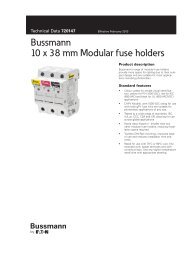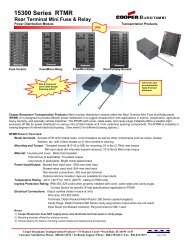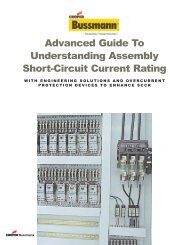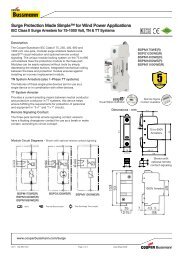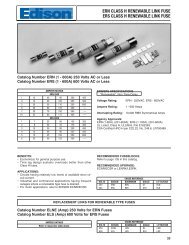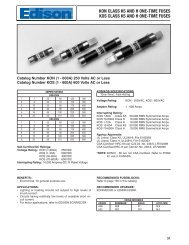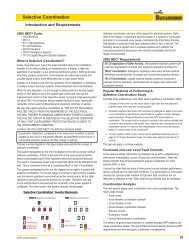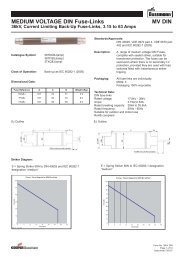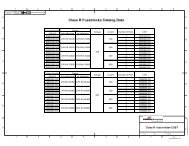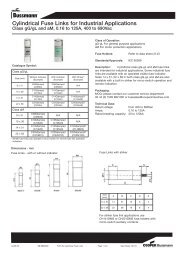What do National Electrical Code® (NEC®) articles 700, 701, and ...
What do National Electrical Code® (NEC®) articles 700, 701, and ...
What do National Electrical Code® (NEC®) articles 700, 701, and ...
You also want an ePaper? Increase the reach of your titles
YUMPU automatically turns print PDFs into web optimized ePapers that Google loves.
KEEP THEPOWER ONFOR VITALLOADSby Evangelos Stoyas P.E.<strong>What</strong> <strong>do</strong> <strong>National</strong> <strong>Electrical</strong> Code ® (NEC ® ) Articles <strong>700</strong>, <strong>701</strong>, <strong>and</strong> 708have in common? They all focus on keeping certain critical loads up <strong>and</strong>running. In some cases, the loads only need to run until the building canbe safely evacuated. In others, the loads must remain energized until theemergency has passed, which could be hours or days.48 NeC DIGEST 2 DECEMBER 2007
It’s that common goal of continued operation ofcertain vital loads that has been driving some changesin the NEC. Perhaps the biggest change that occurredduring the 2008 revision cycle was the introductionof Article 708, Critical Operations Power Systems,designed to keep critical operations required forpublic health <strong>and</strong> safety running during emergencies.But minor changes have also garnered attention.One of those changes concerns selective coordination,which is the operation of protective devices to isolateproblem circuits from the remainder of the systemwithout unnecessarily taking out parts of the systemthat are not in trouble.The reliability of electrical systems supplying vitalloads must be greater than that of the systems supplyingpower to normal loads. People’s health <strong>and</strong> safety relyon the power to these critical loads, even under adverseconditions such as fires, earthquakes, hurricanes, <strong>and</strong>man-made catastrophes. Selective coordination of all theovercurrent protective devices for the circuits supplyingthese loads adds another assurance of reliability.The best way to underst<strong>and</strong> the reason for addingselective coordination requirements to the NEC is toreview the code proposals, comment substantiations,<strong>and</strong> panel statements.New selective coordination requirements went intothe 2005 NEC as Sections <strong>700</strong>.27 <strong>and</strong> <strong>701</strong>.18. The substantiationfor the original proposal for Section <strong>700</strong>.27provides the reasons:“This article specifically m<strong>and</strong>ates that the emergencycircuits be separated from the normal circuitsas shown in [Section] <strong>700</strong>.9(B) <strong>and</strong> that the wiringbe specifically located to minimize system hazards asshown in [Section] <strong>700</strong>.9(C), all of which reduce theprobability of faults, or failures to the system so it willbe operational when called upon. With the interactionof this Article for emergency lighting for egress, it isimperative that the lighting system remain operationalin an emergency. Failure of one component must notresult in a condition where a means of egress will be intotal darkness as shown in [Section] <strong>700</strong>.16….Selectivelycoordinated overcurrent protective devices willprovide a system that will support all these requirements<strong>and</strong> principles. With properly selected overcurrentprotective devices, a fault in the emergencysystem will be localized to the overcurrent protectivedevice nearest the fault, allowing the remainder of thesystem to be functional…Due to the critical nature ofthe emergency system uptime, selective coordinationmust be m<strong>and</strong>ated for emergency systems. This can beaccomplished by both fuses <strong>and</strong> circuit breakers base<strong>do</strong>n the system design <strong>and</strong> the selection of the appropriateovercurrent protective devices.”Similarly, the requirements of Article 708 werecreated to address national security <strong>and</strong> public safetyneeds arising from our dependence on certain vital electricalloads <strong>and</strong> the vulnerability of st<strong>and</strong>ard premiseselectrical systems. In summing up why selective coordinationwas included in this new Article, Code-MakingPanel 20 (CMP-20), which was responsible for it, notedthat “selective coordination is obviously essential forthe continuity of service required in critical operationspower systems. Selective coordination increases the reliabilityof the COPS [critical operations power systems].”Selective coordination requirements first appearedin the Code for circuits supplying elevators in 1993.The 2005 edition of the Code exp<strong>and</strong>ed the selectivecoordination requirements to circuits supplyingvital loads fed from an emergency system—Section<strong>700</strong>.27—or from a legally required st<strong>and</strong>by system—Section <strong>701</strong>.18. This requirement became effectivefor health-care circuits supplying loads required onessential electrical systems—Section 517.26.For the 2008 code cycle, CMP-20 was formedto develop requirements for COPS. The resultingArticle 708 requirements apply to systems supplyingloads that are vital for national security, public safety,or the economy. Selective coordination is requiredfor all overcurrent protective devices in the circuitssupplying COPS loads, according to Section 708.54.Whether the vital load is fed from the normal sourceor the alternate source <strong>do</strong>esn’t matter. The selectivecoordination requirement applies to all overcurrentprotective devices, whether they are in the normalsource path or the alternate source path circuits.<strong>What</strong> Is Selective Coordination?So what is selective coordination <strong>and</strong> how can itbe achieved?In simple terms, selective coordination meansthat, if an overcurrent causes an overcurrent protectivedevice to open, only the nearest upstream fuse orcircuit breaker will open. No other, larger upstreamfuse or circuit breaker should open. In this way, onlythe circuit with the overcurrent condition is interrupted.In a system in which all overcurrent protectivedevices are selectively coordinated, an overcurrentshould only affect the loads where the problem hasoccurred. The other loads still have power.According to Section <strong>700</strong>.27, “Emergencysystem(s),” overcurrent devices shall be selectivelycoordinated with all supply side overcurrent protec-DECEMBER 2007 2 NeC DIGEST 49
Emergency system overcurrent devicestive devices.” The requirements in Sections <strong>701</strong>.18 <strong>and</strong>708.54 are identical, except for the type of systems towhich they apply. Sections <strong>700</strong>.27 <strong>and</strong> <strong>701</strong>.18 containtwo exceptions that clarify selective coordinationapplications.Todd Stafford, senior director with the <strong>National</strong>Joint Apprentice Training Center, is a member ofCMP-13, which is responsible for Articles <strong>700</strong> <strong>and</strong><strong>701</strong>. In the 2005 <strong>and</strong> 2008 code cycles, CMP-13 discussed<strong>and</strong> debated selective coordination.“The committee discussed this topic thoroughly,” hesays. “The words were discussed <strong>and</strong> chosen to be specific,in that ‘Emergency system(s) overcurrent devicesshall be selectively coordinated with all supply sideovercurrent protective devices.’ This means the overcurrentprotective devices from the load branch circuit upthrough to the alternate source <strong>and</strong> from the load branchcircuit up through to the main of the normal source.Both paths are important for a more reliable delivery ofpower. If a fault on the load side of the transfer switchcaused the normal path feeder or main to unnecessarilyopen, we are looking at the alternate source <strong>and</strong> transferswitch needing to activate. There is some probability thatthe generator may not start or the transfer switch maynot transfer, which reduces the system reliability. Also,the analysis should be <strong>do</strong>ne for the fault current suppliedby the normal source <strong>and</strong> by the alternate source toensure the worst case is analyzed.”All emergency overcurrent protective devices mustbe selectively coordinated through to the alternatepower source, <strong>and</strong> the emergency overcurrent protectivedevices on the load side of the transfer switchmust selectively coordinate with the main <strong>and</strong> feederovercurrent protective devices in the normal circuitpath (see Figure 1). However, there is a difference onthe minimum requirement for the overcurrent protectivedevices in the normal source path. Read the textadjacent to the one-line.Figure 1. Selective Coordination of Overcurrent DevicesNormal system overcurrent devices that aresupply side overcurrent devices for emergencysystem overcurrent devicesNormal system overcurrent devicesSelective Coordination Requirement<strong>700</strong>.27 “Emergency system(s) overcurrent devices shall beselectively coordinated with all supply side overcurrentprotective devices”This wording is inclusive of the alternate path <strong>and</strong> normalsource path overcurrent devices for each emergency load.Practical Application Requirement Example:1 must selectively coordinate with 2, 3, 4, 5, 62 must selectively coordinate with 3, 4, 5, 63 must selectively coordinate with 45 <strong>do</strong>es not have to selectively coordinate with 6NormalSource6512NEAlternateSource34ATSHow to Achieve Selective CoordinationFor many years, selective coordination of overcurrentprotective devices has been a common system designpractice for circuits that supply critical business,government, <strong>and</strong> military loads. In the financial <strong>and</strong>communications industries, for instance, where thereare significant <strong>do</strong>llars at risk, many critical loads aredesigned with supply circuits that have selectivelycoordinated overcurrent protective devices. No lessshould be expected for the few important loads thatare critical for life safety.I have spent a career with the U.S. Army Corps ofEngineers specifying <strong>and</strong> designing high-reliabilityelectrical systems for mission-critical operations for allbranches of the military <strong>and</strong> many government agencies.One thing that my experience has taught me is thatselective coordination is important for powering criticalloads for as long as possible, even under adverse physicalcircumstances. This can be <strong>do</strong>ne by either circuit breakersor fuses. Selective coordination of overcurrent protectivedevices is one of the most important studies thatshould be completed when designing systems for emergencyor critical-operations power systems. Qualifiedelectrical power system engineers competent in selectivecoordination can get the task accomplished efficiently.This <strong>do</strong>es not mean any circuit breaker or fuse canbe used indiscriminately. In some cases, specific typesof fuses or circuit breakers may be required. However,many have mischaracterized this as a fuse vs. circuitbreaker issue. That is not the case.As Alan Manche of Square D said on the floor of theNFPA’s 2004 World Safety Conference & Exposition®,“This is not a breaker/fuse issue. You can selectively coordinatewith breakers <strong>and</strong> fuses.” In the 2008 code cycle,experts from several circuit breaker <strong>and</strong> fuse manufacturerspresented to CMP-13 <strong>and</strong> each stated that circuitbreaker <strong>and</strong> fuse systems can both be designed to comply.A range of circuit breaker <strong>and</strong> fuse types an<strong>do</strong>ptions can be used, depending on the specific applicationneeds, including molded-case circuit breakers,insulated-case circuit breakers, low-voltage-powercircuit breakers, <strong>and</strong> current-limiting fuses. In somesituations, relays may be a suitable option.The simplest circuit breaker solution is moldedcasecircuit breakers with instantaneous trips, if theavailable fault currents are sufficiently low. Circuitbreaker manufacturers publish selective coordinationtables for their molded-case circuit breakers that showselective coordination at higher values than obtainableby merely interpreting the time-current curves.New molded-case circuit breakers with fixed highmagneticinstantaneous trips have been introduced forthe very purpose of achieving selective coordinationwith <strong>do</strong>wnstream branch circuit breakers. These circuitbreakers can achieve selective coordination at a much50 NeC DIGEST 2 DECEMBER 2007
As the changes work their way through the industry,the playing field will level out as people becomewilling to pay for more reliable systems.higher fault current than can be achieved by using thest<strong>and</strong>ard adjustable instantaneous trip circuit breakers.Other alternatives include molded-case circuit breakers<strong>and</strong> insulated-case circuit breakers with a short-time delayoption. These circuit breakers typically have an instantaneousoverride to protect the circuit breaker. With thisoption, the designer simply ensures that the fault currentat the <strong>do</strong>wnstream circuit breaker <strong>do</strong>es not exceed theinstantaneous override on the upstream circuit breaker.If fault current <strong>do</strong>es exceed this value, the designer mightuse low-voltage-power circuit breakers or insulated-casecircuit breakers that have short-time delay settings withoutan instantaneous override. With these circuit breakers, it isrelatively easy to achieve selective coordination.In most cases, a study to determine the availableshort-circuit currents throughout the system will berequired when designing with circuit breakers, as willplotting the circuit breakers’ time-current curves foreach circuit path <strong>and</strong> interpreting the results. If selectivecoordination is not achieved, adjustments will berequired in the design or type of circuit breakers.Some people have observed that using short-timedelay settings on circuit breakers increases the arcflashincident energy <strong>and</strong> resulting equipment damage.However, the industry has remedies, such as arc-flashreduction maintenance switches. When a workerneeds to work on or near a circuit that is protected bya circuit breaker with a short-time delay, the arc-flashreductionmaintenance switch can be thrown to theposition that puts the circuit breaker into an instantaneoustrip setting. This lowers the clearing time, <strong>and</strong>incident energy, should an arc fault occur.Another solution is zone-selective interlocking, inwhich the circuit breakers communicate with eachother <strong>and</strong> use short-time delays to achieve selectivecoordination. The other benefit: if a fault occurs ina given circuit breaker’s protection zone, the circuitbreaker can open as fast as possible since the instantaneoussetting overrides the short-time delay. Somedesigners include power inductors <strong>and</strong> isolationtransformers in the system to choke the current <strong>do</strong>wnbelow the circuit breakers’ instantaneous settings.Designing selectively coordinated fuse systems isalso relatively simple. Each low-voltage fuse manufacturerpublishes selectivity ratio guides for its fuses.These ratios are based on the fuse type <strong>and</strong> the ampererating of the fuses. Divide the ampere rating of theupstream fuse by the ampere rating of the <strong>do</strong>wnstreamfuse. If this ampere rating ratio is greater than the ratiopublished by the fuse manufacturer, selective coordinationis achieved up to the fuse’s interrupting ratings.Typically, a short-circuit current analysis is not necessary,nor is plotting the time-current curves.If selectivity ratios are not available, a coordinationstudy is needed. And if the fuse types <strong>and</strong> ampereratings <strong>do</strong> not have sufficient ratios adhering to theminimum published selectivity ratios, different typesof fuses must be used or design changes implemented.<strong>What</strong> About the Cost?Many engineers <strong>and</strong> contractors routinely provideselectively coordinated systems for mission-criticalbusiness loads, <strong>and</strong> many already comply with the newrequirements. As with any significant Code change, therewere objections along the way, among them that theyresult in more work for the engineer <strong>and</strong> a higher pricefor the system. But all the requirements in Articles <strong>700</strong>,<strong>701</strong>, <strong>and</strong> 708 result in extra work <strong>and</strong> cost. An alternatepower source with additional electrical distribution gear,often with sophisticated sensors, monitoring, <strong>and</strong> control,is warranted. It takes extra time <strong>and</strong> money to test,maintain, <strong>and</strong> retain records for these systems to providea reliable system that can provide electrical power todesignated vital loads. The extra cost is expected.When selective coordination results in extra cost,the engineers who conduct a selective coordinationstudy have to account for the extra time in theirbids <strong>and</strong> negotiations with owners or architects. Ifthe equipment an engineer chooses adds to the costof the project, this money must be accounted for inthe equipment bids. As the changes work their waythrough the industry, however, the playing field willlevel out as people become willing to pay for morereliable systems. Reliability <strong>and</strong> availability of systems<strong>and</strong> equipment will become a deciding factor in thefuture. With the use of availability data currentlyfound in NFPA 70B, reliability-centered maintenancewill be able to predict <strong>and</strong> determine maintenancerequirements <strong>and</strong> cost. This, in turn, will be used tojustify the need for selective coordination.For life safety reasons, selective coordination requirementshave exp<strong>and</strong>ed to increase the reliability ofsupplying power to a few critical loads. For the circuitssupplying these loads, all overcurrent protective devicesmust be selectively coordinated. Both fusible systems <strong>and</strong>circuit breaker systems can be designed to comply. 0Evangelos Stoyas, P.E., is chief of the Power ReliabilityEnhancement Program in the Special Missions Office at FortBelvoir, Virginia. He is a member of CMP-20.DECEMBER 2007 2 NeC DIGEST 51



